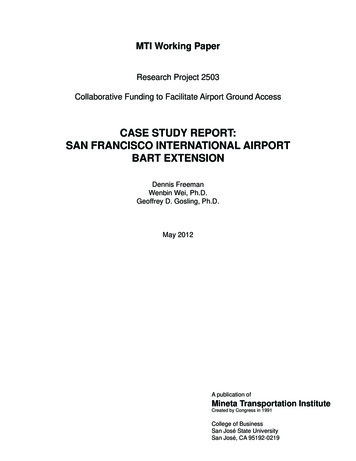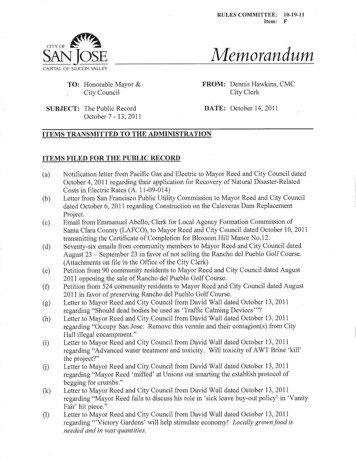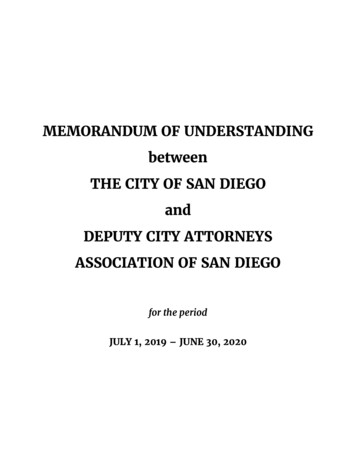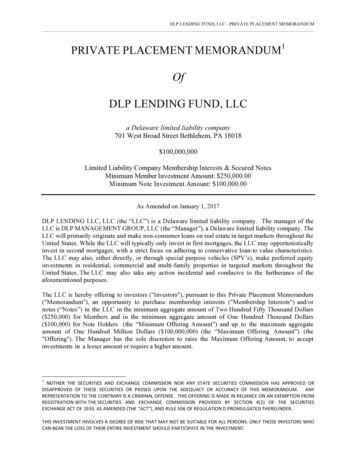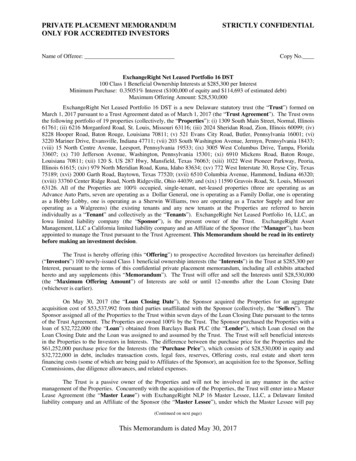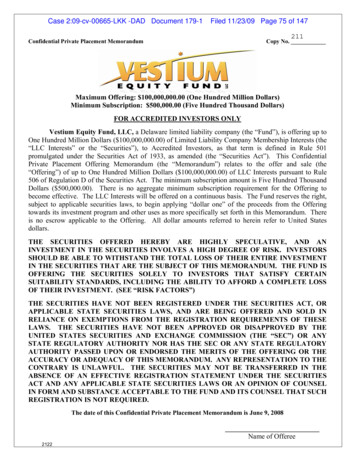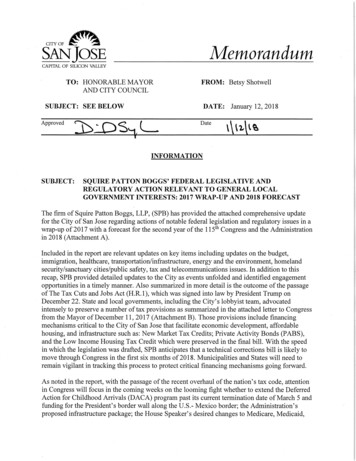
Transcription
CITY OFMemorandumSAN JOSECAPITAL OF SILICON VALLEYTO: HONORABLE MAYORFROM: Betsy ShotwellAND CITY COUNCILSUBJECT: SEE BELOWApprovedDATE: January 12, 2018DateINFORMATIONSUBJECT:SQUIRE PATTON BOGGS’ FEDERAL LEGISLATIVE ANDREGULATORY ACTION RELEVANT TO GENERAL LOCALGOVERNMENT INTERESTS: 2017 WRAP-UP AND 2018 FORECASTThe firm of Squire Patton Boggs, LLP, (SPB) has provided the attached comprehensive updatefor the City of San Jose regarding actions of notable federal legislation and regulatory issues in awrap-up of 2017 with a forecast for the second year of the 115th Congress and the Administrationin 2018 (Attachment A).Included in the report are relevant updates on key items including updates on the budget,immigration, healthcare, transportation/infrastructure, energy and the environment, homelandsecurity/sanctuary cities/public safety, tax and telecommunications issues. In addition to thisrecap, SPB provided detailed updates to the City as events unfolded and identified engagementopportunities in a timely manner. Also summarized in more detail is the outcome of the passageof The Tax Cuts and Jobs Act (H.R.1), which was signed into law by President Trump onDecember 22. State and local governments, including the City’s lobbyist team, advocatedintensely to preserve a number of tax provisions as summarized in the attached letter to Congressfrom the Mayor of December 11, 2017 (Attachment B). Those provisions include financingmechanisms critical to the City of San Jose that facilitate economic development, affordablehousing, and infrastructure such as: New Market Tax Credits; Private Activity Bonds (PABS),and the Low Income Housing Tax Credit which were preserved in the final bill. With the speedin which the legislation was drafted, SPB anticipates that a technical corrections bill is likely tomove through Congress in the first six months of 2018. Municipalities and States will need toremain vigilant in tracking this process to protect critical financing mechanisms going forward.As noted in the report, with the passage of the recent overhaul of the nation’s tax code, attentionin Congress will focus in the coming weeks on the looming fight whether to extend the DeferredAction for Childhood Arrivals (DACA) program past its current terminati on date of March 5 andfunding for the President’s border wall along the U.S.- Mexico border; the Administration’sproposed infrastructure package; the House Speaker’s desired changes to Medicare, Medicaid,
HONORABLE MAYOR AND CITY COUNCILSubject: Federal Legislative and Regulatory Action Relevant to General Local Government Interests: 2017Wrap-Up and 2018 ForecastJanuary 12, 2018Page 2Social Security and welfare programs; and perhaps another attempt to repeal and replace theAffordable Care Act (ACA). It remains to be seen however if the new Republican majority in theSenate of 51-49 will have the votes necessary to repeal ACA in 2018.Adding to this activity will be the need for Congress to address the FY 2018 budget ContinuingResolution (CR) which is set to expire on January 19 or face a government shutdown.This Federal legislative and regulatory update reflects many of the City’s 2017 legislative policygoals and priorities and the City’s efforts to work with our federal partners to advocate on issuesof concern and interest to the City during the first year of the 115th Congress./s/BETSY SHOTWELLDirector, Intergovernmental RelationsAttachment A:Squire Patton Boggs’ Federal Legislative and Regulatory Action Relevant to General LocalGovernment Interests: 2017 Wrap-Up and 2018 ForecastAttachment B:Correspondence to Federal Tax Reform Conference Committee Leaders and various Members ofCongressFor more information contact please contact Betsy Shotwell, Director of IntergovernmentalRelations at: (408) 535-8270
Squire Patton Boggs (US) LLP2550 M Street, NWWashington, DC 20037Memorandum 1 202 457 6000 1 202 457 quire Patton Boggs LLPDecember 29, 2017Federal Legislative and Regulatory Action Relevant to General LocalGovernment Interests: 2017 Wrap-Up and 2018 ForecastThis report provides a comprehensive update for local governments and their partners highlightingactions on notable federal legislation, administration, and regulatory issues in 2017, as well as a lookahead into what we expect in the second year of the Trump Administration and Republican-led Congress.It is important to note that the memorandum provides only a high-level perspective, as detailed reportswere provided as events unfolded in Congress and the administration.In terms of legislation enacted into law, the first year of the Trump Administration and the 115th Congressproved to be the least productive in four decades, with less than 100 laws enacted in 2017. Moreover, thePresident failed to achieve many of the goals he set forth for his first 100 days in office, including: the banof all federal funding to “sanctuary cities”; removal of two million criminal illegal immigrants; investmentof 1 trillion in U.S. infrastructure; and the suspension of immigration from terror-prone regions. Despitethe President’s efforts to take administrative action via Executive Orders and Memoranda on a numberof these issues, many were halted by federal judges or are being held up by pending lawsuits. Perhapsmost dramatic was the failure of Congress’ attempt to repeal the Affordable Care Act.However, this inaction is somewhat overshadowed by the significance of the appointment of SupremeCourt Justice Neil Gorsuch and the end-of-year overhaul of the nation’s tax code. Looking to build on thismomentum, the President will announce his 2018 legislative agenda in early January. Congressionalleaders, having pushed most of its year-end work into January, will face a daunting number of must-passdeadlines when the Senate returns on January 3 and the House reconvenes on January 8. Most pressingwill be the January 19 deadline to approve an FY 2018 budget or face a government shutdown. With onlya limited number of legislative days before the deadline, resolution of the budget will most certainly becomplicated by the anticipated standoff between the President and Democrats over his insistence thatany agreement on continuation of the Deferred Action for Childhood Arrivals (DACA) program includefunding for his proposed wall along the U.S.-Mexico border.ATTACHMENT A
Among the issues we expect to see at the forefront of the 2018 federal agenda:FY 2018 Budget and Other Fiscal Issues: Congress avoided the year-end fiscal “cliffmas” by approving arelatively straightforward Continuing Resolution (CR) that will provide funding for the federal governmentthrough January 19. However, without agreement on topline FY 2018 spending and a number of othercontentious policy items, another fiscal cliff is looming in January. As detailed below, a bipartisan budgetagreement is necessary to establish topline spending for FY 2018. Lacking topline numbers, appropriatorscannot move forward with an omnibus package. Also playing into the fiscal standoff is another disastersupplemental and the upcoming debt ceiling lapse (currently estimated for March). The President isreportedly on schedule to submit his FY 2019 budget request to Congress in early February, creating ascenario in which the FY 2019 budget request precedes resolution of the FY 2018 appropriations process.Infrastructure: Now that tax reform has been completed, we anticipate Congress and the administrationwill turn attention to an infrastructure package. President Trump included an infrastructure outline in hisFY 2018 budget; additional details on his proposal are expected in January. Congress is also expected toact on the reauthorization of the Federal Aviation Administration (FAA) before the current extension ofFAA programs lapses on March 18.Immigration: The most pressing immigration issue is what Congress will do concerning the DeferredAction for Childhood Arrivals (DACA) program, which will terminate, per President Trump’s directive, onMarch 5. As part of tax reform negotiations, it is reported that a Senate vote on DACA and border securitywas promised for January. Strong divisions remain over how to address citizenship and the limitations ofcoverage.Intelligence Reform: As noted below, the year-end Continuing Resolution included a short-term extensionof Section 702 of the Foreign Intelligence Surveillance Act, which allows the National Security Agency tomonitor communications sent by certain foreign entities without a warrant. A longer-term extension ofthe program will be contentious.Healthcare: Senator Susan Collins’ (R-ME) vote on the tax reform package – which removed the individualmandate penalty of the Affordable Care Act – was dependent on an agreement with Senate MajorityLeader Mitch McConnell (R-KY) and the President that two market stabilization measures would bebrought up for a vote in January.Entitlement Reform: House Speaker Paul Ryan (R-WI) has long sought to advance entitlement reform –including Medicare, Medicaid, Social Security, and welfare programs – and indicated that this would be apriority in 2018. However, Senate Majority Leader McConnell expressed reluctance to the strategy. Facingcertain Democratic opposition, entitlement reform would need to be done through the reconciliationprocess, requiring Republican unity, and many moderate Republicans are wary of addressing entitlementsin that manner.Tax: In addition to a likely technical corrections bill on the recent tax reform package, Congress will alsoconsider a tax extender package introduced by Senate Finance Chairman Orrin Hatch (R-UT) in lateDecember.2
ISSUE AREA REVIEW AND FORECASTS PRESIDENTIAL EXECUTIVE ORDERS . 4 BUDGET/APPROPRIATIONS. 4 IMMIGRATION/HOMELAND SECURITY/PUBLIC SAFETY . 6 HEALTHCARE . 10 TAX . 13 TRANSPORTATION/INFRASTRUCTURE. 15 ENERGY AND ENVIRONMENT . 18 WATER . 20 NUTRITION .22 HOUSING AND COMMUNITY DEVELOPMENT . 22 WORKFORCE AND JOB TRAINING . 24 TELECOMMUNICATIONS . 24 CYBERSECURITY. 25 TRADE. 28 BASE REALIGNMENT AND CLOSURES (BRAC) . 30 EXPORT-IMPORT BANK . 313
PRESIDENTIAL EXECUTIVE ORDERSSince September, President Trump signed nine executive orders: Restoring State, Tribal, and Local Law Enforcement’s Access to Life-Saving Equipment andResources (this order rescinds President Obama’s 2015 executive order banning the acquisitionof certain military-style equipment by local law enforcement);Order Regarding the Proposed Acquisition of Lattice Semiconductor Corporation by ChinaVenture Capital Fund Corporation Limited;Imposing Additional Sanctions with Respect to North Korea;Order on the Revocation of Executive Order Creating Labor-Management Forums;Order on the Continuance of Certain Federal Advisory Committees;Promoting Healthcare Choice and Competition Across the United States;Resuming the United States Refugee Admissions Program with Enhanced Vetting Capabilities;Order Amending Executive Order 13223 (Ordering the Ready Reserve of the Armed Forces toActive Duty and Delegating Certain Authorities to the Secretary of Defense and Secretary ofTransportation); andRevising the Seal for the National Credit Union Administration.BUDGET/APPROPRIATIONSFY 2018 APPROPRIATIONSDespite giving themselves an extra two weeks and extending the FY 2018 Continuing Resolution (CR) fromDecember 8 through December 22, Congressional leaders and the administration were still unable tocome to an agreement on topline spending for FY 2018; hence, before recessing for the year, Congressapproved another CR (H.R. 1370) that will fund the government through January 19.As has become typical in budget negotiations, a number of policy and funding items were discussed in theweeks leading up to the CR; however, in the end, the CR was relatively “clean,” with Congress leaving themost contentious items for action in early 2018. The CR maintained spending at FY 2017 levels andincluded: A waiver of the PAYGO Act of 2010, which would have forced mandatory spending cuts, including 25 billion to Medicare, to offset the deficit increases resulting from the tax reform bill; 2.85 billion for the Children’s Health Insurance Program (CHIP), funding the program fromOctober 1, 2017 through March 31, 2018;An extension of the controversial Section 702 of the Foreign Intelligence Surveillance Act (FISA),which allows warrantless monitoring of communication, through the term of the CR (January 19);Funding to maintain the National Flood Insurance Program through January 19; 2.1 billion for the Veterans Choice Program, which is expected to maintain the program throughfall 2018; and 4.6 billion for missile defense programs and repair of two Navy destroyers.4
Among the items awaiting resolution in early 2018 that will likely wrap into spending negotiations: The Deferred Action for Childhood Arrivals (DACA) program;Funding for the border wall;Additional funding to address the national opioid crisis;Funding for pension shortfalls;Additional disaster aid; andAffordable Care Act cost-sharing subsidies.Without a bipartisan budget agreement on topline spending, sequestration-level spending caps mandatedby the Budget Control Act of 2011 (BCA/P.L. 112-25) will be implemented in 2018: 549 billion for defenseand 516 billion for nondefense spending (for comparison, FY 2017 levels are 551 billion for defense and 518.5 billion for nondefense). The most recent proposal by the GOP – which Democrats rejected – wouldhave raised defense spending by 54 billion and nondefense spending by 37 billion in each of FY 2018and FY 2019. Democrats have insisted on parity in prior budget agreements, with resulted in equal abovesequestration increases to defense and nondefense spending. However, a policy “win,” such as DACA orhealthcare, may sway Democrats to support an uneven increase, as they did in FY 2017 when theysupported an additional 15 billion for defense and 3 billion for nondefense programs, but weresuccessful in rejecting proposed offsets and border wall construction.The House passed an FY 2018 omnibus bill (H.R. 3354) in September and the Senate AppropriationsCommittee approved its final FY 2018 spending bill in November, both of which ignore the BCA spendingcaps. Once an agreement is reached on topline numbers, appropriators will need at least three weeks toreconcile the pending bills and draft an omnibus package. With the House return now pushed to January8, the CR expiring on January 19, no budget agreement in sight, and a number of policy items that willrequire attention in January, resolution of the FY 2018 budget process remains very much “to bedetermined.”DISASTER FUNDINGIn addition to the year-end Continuing Resolution (CR), the House also approved an 81 billion disastersupplemental (H.R. 4667). The Senate did not take up the measure, instead leaving it for consideration inJanuary.The 81 million package is nearly double the 44 billion requested by the administration. It would providefunds to Texas, Florida, Puerto Rico, the U.S. Virgin Islands, Louisiana, and California, to address continuedrecovery from Hurricanes Harvey, Irma, and Maria, as well as recent wildfires. If approved, it would bringthe total of recent disaster aid to nearly 133 billion.FY 2019 TRUMP BUDGETThe administration reports it is on track to deliver the President’s FY 2019 Budget Proposal to Congress inearly February.5
IMMIGRATION/HOMELAND SECURITY/PUBLIC SAFETYDEFERRED ACTION FOR CHILDHOOD ARRIVALS (DACA)Since President Trump’s September announcement terminating the Deferred Action for ChildhoodArrivals (DACA) program by March 5, 2018, Congress renewed its efforts and introduced additionallegislative measures designed to codify DACA protections under federal statute or provide similar reliefto eligible DREAMers residing in the U.S.Reflecting the bipartisan support for a solution, House and Senate Democrats urged congressionalleadership to include a legislative DACA fix in FY 2018 appropriations legislation, and at least 34 HouseRepublicans urged Speaker Paul Ryan (R-WI) to address DACA by the end of the year. Speaker Ryancreated a Republican working group in the House focused on developing a legislative fix codifying DACAprotections under law, including: House Speaker Paul Ryan (R-WI)House Majority Leader Kevin McCarthy (R-CA)House Homeland Security Committee Chairman Mike McCaul (R-TX)House Judiciary Committee Chairman Bob Goodlatte (R-VA)Representative Raul Labrador (R-ID)Representative Mario Diaz-Balart (R-FL)Representative John Carter (R-TX)Representative Will Hurd (R-TX)Representative Martha McSally (R-AZ)Representative Jim Sensenbrenner (R-WI)Senate Judiciary Committee Chairman Chuck Grassley (R-IA) introduced legislation, the Security,Enforcement, and Compassion United in Reform Efforts (SECURE) Act (S. 2192), designed to combine aDACA fix with broader immigration enforcement legislation in an effort to address DACA with stand-alonelegislation, rather than in year-end appropriations legislation. The SECURE Act contains the Senate GOP’sborder security and immigration enforcement legislation, the Building America’s Trust Act (S. 1757), whichwas introduced earlier this year by Senator John Cornyn (R-TX).The SECURE Act would authorize approximately 15 billion over four years for a long-term border securityand interior enforcement strategy. Alongside authorizing and requiring the deployment of a wall system,fencing, levees, technology, and other physical barriers along the southern border wall, the bill would: Increase the number of Border Patrol agents, Immigration and Customs Enforcement (ICE)officers, immigration judges, and federal prosecutors;Authorize partnerships between the Department of Homeland Security (DHS) and state and locallaw enforcement to help identify and remove criminal illegal immigrants; andImpose tough penalties on federal funds for jurisdictions considered to be non-compliant withfederal immigration enforcement requests.The SECURE Act includes provisions identical to those in Kate’s Law (H.R. 3004), which would sharplyincrease mandatory minimums for undocumented immigrants who repeatedly re-enter the United Statesfollowing deportation.6
The bill also contains the Bar Removal of Individuals who Dream and Grow our Economy (BRIDGE) Act (S.128), originally introduced by Senators Dick Durbin (D-IL) and Lindsey Graham (R-SC). The provision directsDHS to grant provisional protected status and employment authorization to undocumented immigrantsmeeting certain eligibility criteria. Eligible individuals are undocumented immigrants who: (1) arrived inthe United States before the age of 16; (2) have continuously resided in the United States since June 15,2007; (3) have enrolled in school or have obtained a high-school diploma; (4) have not been convicted ofa felony or serious misdemeanor; and (5) do not pose a threat to national security or public safety. TheSECURE Act does not provide an eventual path to citizenship for DREAMers who qualify for provisionalprotected status.The legislation would also permanently authorize the E-Verify program and provide incentives for smallbusinesses to participate. Additionally, the bill enhances the number of diplomatic security personnelfocused exclusively or primarily on preventing and detecting visa fraud.In October, the White House sent a letter to House and Senate leadership outlining the administration’spriorities for immigration policy. The President emphasizes the importance of providing funding for a U.S.southern border wall, addressing the backlog of pending asylum cases, discouraging illegal re-entry, andamending current law to ensure Unaccompanied Alien Children (UACs) can be expeditiously removedfrom the U.S.The White House proposes the withholding of certain federal funds administered by DOJ and DHS torecipients considered to be sanctuary jurisdictions, and also emphasizes the need to enhance cooperationbetween the federal government and states and localities relating to the enforcement of immigration law.Additionally, the White House proposes establishing a merit-based immigration system that: (1) limitsfamily-based green cards for spouses and minors; (2) implements a points-based system for awardinggreen cards; (3) eliminates the “Diversity Visa Lottery”; and (4) limits the number of accepted refugees.Reportedly, Senate Majority Leader Mitch McConnell promised a vote on a DACA/border security bill inJanuary.BORDER WALL/IMMIGRATIONThe President’s FY 2018 budget request proposed a 2.9 billion funding increase for U.S. Customs andBorder Protection (CBP), which included 1.6 billion for 32 miles of wall construction along the U.S.Mexico border. Both House and Senate versions of pending FY 2018 Homeland Security appropriationslegislation contain 1.6 billion to begin the construction of a physical barrier along the southern border.On December 5, CBP released a year-end report on border security efforts, providing an overview of thestate of border crossings in FY 2017. CBP reports that FY 2017 marked the lowest level of illegal bordercrossings on record, a 23.7 percent decrease from FY 2016 levels. Following the release of the report,senior CBP officials emphasized the importance of building a southern border wall despite the FY 2017decline in border crossings.In late November, CBP began testing eight border wall prototypes constructed in the San Diego area overthe summer. According to CBP, the prototypes will undergo a series of evaluations in the coming monthsto test each prototype’s anti-breaching, anti-climbing, and anti-digging capabilities.7
SANCTUARY CITIESOn November 15, the Department of Justice (DOJ) sent letters to 29 jurisdictions informing them that theymay have laws, policies, or practices in place that potentially violate 8 U.S.C. 1373 (Section 1373), a federalstatute which restricts local law enforcement agencies from prohibiting the sharing of an individual’simmigration or citizenship information with the federal government.The letters reminded each recipient that they certified Section 1373 compliance as a condition to receiveFY 2016 Edward Byrne Memorial Justice Assistance Grant (Byrne JAG) funding. The letters requested thateach recipient submit a response to DOJ addressing whether that jurisdiction would comply with Section1373 throughout the entirety of an FY 2017 Byrne JAG award, should it be selected for funding (at thetime of this memorandum, DOJ has yet to award FY 2017 Byrne JAG funding). The letters note that DOJhas not made a final determination regarding the selected jurisdictions’ compliance with Section 1373.The following jurisdictions received letters from DOJ: Albany, New York;Berkeley, California;Bernalillo County, New Mexico;Burlington, Vermont;Contra Costa County, California;City and County of Denver, Colorado;Fremont, California;Jackson, Mississippi;King County, Washington;Lawrence, Massachusetts;Los Angeles, California;Louisville Metro, Kentucky;Middlesex, New Jersey;Monterey County, California;Multnomah County, Oregon;Newark, New Jersey;Riverside County, California;Sacramento County, California;City and County of San Francisco, California;Santa Ana, California;Santa Clara County, California;Seattle, Washington;Sonoma County, California;Washington, District of Columbia;Watsonville, California;West Palm Beach, Florida;State of Illinois;State of Oregon; andState of Vermont.8
On November 20, a U.S. District Judge issued a permanent order ruling President Trump’s sanctuary cityexecutive order (EO) titled “Enhancing Public Safety in the Interior of the United States” unconstitutional.Judge William Orrick of the U.S. District Court for the Northern District of California permanently nullifiedthe EO, which directed DOJ to withhold certain federal grant funding from jurisdictions considered to benon-compliant with 8 U.S.C. 1373.In April 2017, Judge Orrick issued a temporary injunction against the EO in favor of litigation filed by theCounty of Santa Clara and the City and County of San Francisco. In issuing the temporary injunction, JudgeOrrick stated that the President’s EO would cause municipalities to experience constitutional injurythrough the violation of the separation of powers doctrine and by depriving jurisdictions of their Fifth andTenth Amendment rights.Judge Orrick upheld his initial temporary injunction, arguing that the “Tenth Amendment requires thatconditions on federal funds be unambiguous and timely made; that they bear some relation to the fundsat issue; and that they not be unduly coercive. Federal funding that bears no meaningful relationship toimmigration enforcement cannot be threatened merely because a jurisdiction chooses an immigrationenforcement strategy of which the President disapproves.”Following Judge Orrick’s original temporary injunction, Attorney General Jeff Sessions vowed to continueto litigate the case. After the November decision to uphold the ruling, DOJ stated that the District Courtexceeded its authority “when it barred the President from instructing his cabinet members to enforceexisting law. It is expected that the Justice Department will vindicate the President’s lawful authority todirect the executive branch.” Judge Orrick’s permanent injunction can be found here.Following the recent acquittal of Jose Ines Garcia Zarate, an undocumented immigrant charged withinvoluntary manslaughter and assault with a deadly weapon relating to the death of San Franciscoresident Kate Steinle, President Trump and Attorney General Sessions have repeatedly emphasized theirintent to continue fighting sanctuary policies.MARIJUANADepartment of Justice (DOJ) officials met in November to discuss potential changes to federal marijuanaenforcement policy. Following the meeting, Attorney General Jeff Sessions said, “It’s my view that the useof marijuana is detrimental and we should not give encouragement in any way to it. And it represents afederal violation which is in the law and is subject to being enforced.” These comments by AG Sessionsfollow his statements just two weeks prior at a House Committee on the Judiciary hearing where hetestified that the Trump Administration is continuing, at least for now, the Obama-era policy of generallyrespecting the right of states to set their own marijuana laws without federal interference, as outlined bythe Cole Amendment. During the November hearing, AG Sessions also conceded that cannabis is not asdangerous as heroin, despite both substances currently being classified under Schedule I of the ControlledSubstances Act – a category reserved for drugs with a high potential for abuse and no medical value.During the November hearing, AG Sessions acknowledged that DOJ is bound by a federal budget rider thatbars the federal government from spending money to interfere with state medical cannabis laws andasked that similar language not be included in FY 2018 spending legislation.The Senate Committee on Appropriations included two marijuana-related amendments in its FY 2018Commerce-Justice-Science (CJS) Appropriations legislation. The first is Senator Pat Leahy’s (D-VT)9
amendment, which would prohibit the federal government from intervening in state operations ofmedical marijuana, and the second is Senator Jeff Merkley’s (D-OR) amendment, which would prohibitthe federal government from interfering with any activity under a state law that authorizes the use,distribution, possession, or cultivation of industrial hemp. The House CJS Appropriations bill does notinclude any language offering states medical marijuana protections. The decision of whether to includethis language in a final FY 2018 spending package will likely cause a contentious debate between the twochambers as they conference the bills next year.HEALTHCAREAFFORDABLE CARE ACT (OBAMACARE) REPEAL AND REPLACEOver the course of the year, Republicans were unsuccessful in their efforts to repeal and replace thePatient Protection and Affordable Care Act (ACA/H.R. 3590), also known as Obamacare. Following Housepassage of the American Health Care Act (AHCA/H.R. 1628) in May, the Senate considered – and failed topass – a variety of repeal measures. Most notably, the Better Care Reconciliation Act of 2017(BCRA/Amendment to H.R. 1628) met its fate in late July following somewhat unexpected dissension fromRepublican Senators Susan Collins (R-ME), Lisa Murkowski (R-AK), and John McCain
ATTACHMENT A Memorandum Squire Patton Boggs (US) LLP 2550 M Street, NW Washington, DC 20037 O 1 202 457 6000 F 1 202 457 6315 squirepattonboggs.com FHHS From: Squire Patton Boggs LLP Date: December 29, 2017 Subject: Federal Legislative and Regulatory Action Relevant to General Local Government Interests: 2017 Wrap-Up and 2018 Forecast

